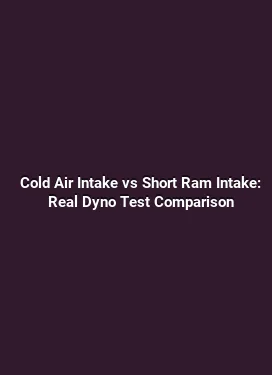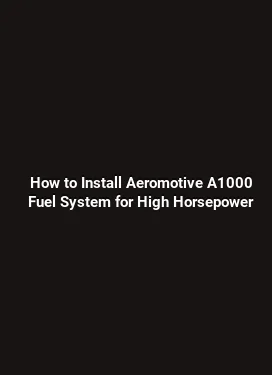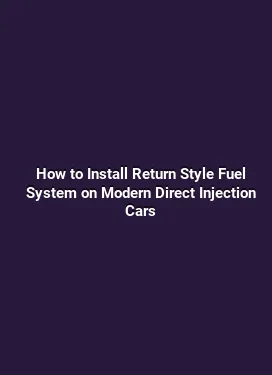Best Fuel Line Sizing for High Horsepower Builds: Complete Chart
When pushing a high horsepower build, the fuel delivery system becomes one of the most critical links between airflow and combustion efficiency. A well-designed fuel line network ensures consistent pressure, minimal impedance, and reliable supply under high load, track conditions, and extreme RPMs. This guide dives into practical sizing strategies for fuel lines, fuel rails, and associated components within intake and fuel systems, providing actionable benchmarks and real-world reasoning that go beyond simple specifications.
Fundamentals: Why Line Sizing Matters in High HP Applications

Fuel line sizing is not a single number, but a balance among flow capacity, pressure drop, and compatibility with the rest of the fuel system. In high horsepower builds, the engine demands rapid fuel delivery during wide open throttle and peak torque events. If the line is too narrow or the routing introduces additional resistance, fuel pressure can sag just when it is needed most, leading to lean misfires, throttle hesitation, or inconsistent power output. Conversely, an oversized line can add weight, cost, and potential susceptibility to vapor lock in certain environments. The goal is to achieve steady fuel pressure with minimal dynamic drop across RPM and load ranges.
Two core concepts drive line sizing decisions: flow capacity and pressure drop. Flow capacity is typically expressed in gallons per hour (GPH) or liters per hour (LPH) at a given pressure. Pressure drop, on the other hand, reflects how much pressure is lost from the fuel tank to the injector rail as fluid traverses tubing, fittings, and any restrictions in the path. For high horsepower builds, the interaction between fuel pressure regulator behavior, injector spray pattern, and line impedance becomes especially important, as it determines how consistently the engine can maintain target air-fuel ratios under demanding conditions.
Key Components: What Needs Sizing in a High HP Intake & Fuel System
A robust high horsepower fuel system typically includes a combination of a capable pump, adequately sized feed and return lines, a properly matched fuel rail, and precise regulator control. Each element contributes to overall performance, and misalignment in any single part can create bottlenecks. The main components to size and verify are fuel pump capacity, fuel line diameter (supply and return), line routing length, filter placement, and injector type compatibility. In many builds, an auxiliary fuel pressure regulator or a return-type system helps maintain stable pressure at the rail across different operating modes.
In intake systems, the interplay between air intake velocity and fuel delivery becomes visible when high-volume airflow requires exact timing of injector opening and spray convergence. The fuel rails must supply equal pressure across all injectors, which is influenced by line length differences, injector height, and rail design. A balanced approach reduces the risk of fuel starvation at high rpm where each injector may demand peak flow for several milliseconds per cycle.
Baseline Measurements: What to Start With

For engines producing up to roughly 600 horsepower, a common starting point for fuel lines is a 3/8 inch (9.5 mm) inner diameter feed line with a parallel return line of similar size, paired with a capable pump in the 340–525 LPH range. As horsepower increases beyond this range, consider increasing feed to 1/2 inch (12.7 mm) or larger in sections where the line experiences the most pressure drop, and ensure the return path can handle the surplus at full load. These numbers are not one-size-fits-all; they serve as a practical baseline for planning and comparison as you tailor the build to your specific engine, fuel type (gasoline, E85, methanol blends), and intended use (drag, road racing, or endurance).
It is essential to photograph and map the entire fuel path, from the tank to the injector, noting each bend, length, and connection. Running a common-mode length analysis helps identify potential hotspots where pressure could drop. In bouncing between potential configurations, an emphasis on minimal elbow count, smoother transitions, and properly sized hoses can yield tangible gains in pressure stability and injector performance.
Pressure Targets and Flow Requirements: Translating Horsepower into Specs
Fuel pressure targets vary with engine management strategies, injector size, and the fuel’s stoichiometry. When targetting high horsepower, a typical gasoline setup might aim for rail pressures in the 45–60 psi range for common port injections, with higher pressures for direct injection or E85 conversions. The exact figure depends on injector design, rail geometry, and the common rail or regulator arrangement. For systems using return-type plumbing, the pressure regulator or the pump’s internal regulation must be capable of maintaining the desired rail pressure even as engine demand spikes. For boost-centric engines or forced induction, rail pressure targets can rise to 60–85 psi or more, demanding careful attention to line strength and regulator headroom.
Flow capacity should be assessed at the highest anticipated engine demand, not just idle or light load. A practical method is to calculate the required GPH by multiplying the engine’s maximum air flow (in pounds per hour) by an appropriate fuel air ratio, then converting to volumetric flow. This calculation provides a ceiling for the fuel delivery system and helps compare options across pumps, lines, and rails. In real-world terms, a high horsepower build often requires a fuel system engineered for headroom, not just the bare minimum to satisfy nominal conditions.
Choosing Pumps with Adequate Headroom
Pump selection hinges on maintaining pressure across the rpm and boost envelope with minimal performance sag. For naturally aspirated setups in the 500–700 horsepower range, a high-flow pump in combination with a properly sized feed line generally suffices. When pushing beyond 800+ horsepower, especially in boosted applications, it’s common to pair two pumps in parallel or employ high-performance ethanol-compatible pumps that maintain stable flow across a wide pressure range. The rationale is to reduce the risk of cavitation and starvation during aggressive acceleration or sustained high-rpm operation.
Fuel rail availability and injector compatibility must be considered in tandem with pump choice. Injectors with larger leakage rates or shorter spray durations can influence the effective pressure at the rail. Ensuring an injector map that aligns with the chosen pressure target helps avoid oversupply or lean conditions during peak demand. In parallel, secondary filters or dedicated fuel filtration close to the pump can improve delivery consistency by removing particulates that might clog injectors or create flow restrictions.
Line Routing, Fittings, and Real-World Installation Tips
Route planning is more than a neat diagram; it directly affects pressure stability under dynamic conditions. Favor straight runs with gradual bends, and minimize total length while respecting engine bay packaging. Long, winding routes introduce frictional losses and potential heat soak that can alter fuel viscosity and pressure readings. Using high-quality stainless steel braided hose with compatible fittings can provide reliable performance under high temperature and vibration. Always verify compatibility with the fuel type, especially when using ethanol blends that can degrade certain elastomers over time.
Fittings and connections are common weak points. Each flare, compression, or push-lock connection adds a potential site for micro-leaks or flow restriction. A practical approach is to use a consistent type of fitting throughout the system and replace seals at regular maintenance intervals. When routing near hot exhaust components or turbochargers, insulating sleeves and protective clips help prevent premature hose aging and potential failure under high boost or engine bay heat. Pressure testing the entire path before final startup is a crucial step to ensure there are no hidden leaks or weak points.
Return vs. Returnless Systems: Pros and Trade-Offs
Return-type systems inherently regulate rail pressure by returning unused fuel to the tank, which can help in maintaining stable pressure during high demand but adds complexity in routing and heat management. Returnless systems simplify routing and can be more compact inside tight engine bays, but they demand precise regulation at the pump or rail to keep rail pressure within target ranges. The decision often comes down to space, maintenance preferences, and how aggressive the engine tuning is. In high horsepower builds driven by modern engine management, returnless configurations paired with a capable, high-flow pump can deliver similar stability with streamlined plumbing.
Another factor is the fuel type’s impact on pressure behavior. Ethanol blends tend to alter viscosity and surface tension, affecting injector performance and pressure droop characteristics. When running E85 or methanol-based fuels, it is prudent to verify rail pressure stability across temperature changes and volume demands, because the higher octane and cooling effects can foster different spray patterns and fueling needs during peak power events.
Practical Chart: A Stepwise Sizing Approach for Different HP Bands
The objective of a sizing chart is to translate theoretical calculations into actionable, install-ready benchmarks. Below is a practical, scalable framework you can adapt to your build. It is not a universal table but a method to derive the appropriate sizing for your specific components and goals. Start by defining the engine’s target horsepower, the expected operating environment (drag strip, road racing, street), and the fuel type. Then, work through the following steps to narrow down line diameter, pump capacity, and rail compatibility.
Step 1 – Determine target rail pressure range based on injector data and engine power band. Step 2 – Estimate maximum fuel flow demand (GPH/LPH) at the highest RPM/boost. Step 3 – Choose a feed line diameter that yields acceptable pressure drop at peak flow. Step 4 – Select a return line diameter that can move the excess fuel without creating a bottleneck. Step 5 – Verify that the pump(s) meet combined flow and head requirements plus adequate headroom for pressure regulation. Step 6 – Confirm rail and regulator compatibility, ensuring a matched flow and pressure response across the operating envelope. Step 7 – Validate via pressure tests and road dyno sessions, tracking rail pressure, injector duty cycle, and air-fuel stability across RPM and load.
As an example, a high horsepower NA build targeting 650–750 horsepower at the crank with gasoline fuel may begin with a 1/2 inch feed line and 1/4 inch return in the short run, a robust high-flow pump in the 525–750 LPH range, and a rail designed for a rail pressure around 55 psi at peak load. If measurements show noticeable pressure drop at high rpm, incrementally increasing the feed line diameter or adding a second feed path can reduce the drop. In boosted scenarios, a returnless setup with a dual-pump arrangement and a rail designed for elevated pressures (60–75 psi) is a common path toward improved stability and repeatability.
For practical tuning, keep the focus on measurable indicators you can log during testing: rail pressure stability, injector duty cycle, fuel temperature, and pressure drop across the line, particularly at ignition events. The best configurations reveal themselves through repeated data collection, not a single test ride or dyno pull. Trend analysis helps identify whether the system remains within safe margins during aggressive acceleration or when the engine operates near its redline.
Maintenance and Longevity Considerations
High horsepower fuel systems demand proactive maintenance to sustain performance. Regular inspection of hose condition, line integrity, and fittings helps identify early signs of wear before a failure occurs. Ethanol-compatible hoses and clamps should be checked for swelling, cracking, or chemical degradation. A clean fuel filter and a strategic placement of filters near the pump can help prevent debris from reaching injectors, extending their service life and maintaining consistent spray patterns. It is also wise to inspect the fuel pressure regulator for any drift in setpoints, particularly in systems that experience heat soak or frequent rapid pressure fluctuations during high-load events.
Seasonal storage or extended idle periods can introduce sediment buildup or moisture-related issues. A simple fuel stabilizer protocol and periodic fuel system flushes help preserve performance, especially on engines that sit for prolonged periods between track days. By maintaining clean lines and predictable pressure behavior, the system delivers repeatable performance from one event to the next.
Real-World Examples: From Concept to Chart Realization
In practice, many builders approach fuel line sizing by mapping the entire system according to a pragmatic set of constraints: space in the engine bay, compatibility with chosen fuel, and the engine’s anticipated operating window. A small, compact setup may suffice for a street-driven high-performance vehicle, while a dedicated race car often requires larger feed lines, multiple feed sources, and sophisticated return management to achieve stable pressure during long runs at high power. The core lesson is to align the physical layout with the engine’s fueling demands and to validate through rigorous testing under load. When in doubt, building in headroom in both flow capacity and pressure targets tends to yield better reliability across a broader range of operating scenarios.
Finally, consider the entire intake and fuel ecosystem as a unit. A well-sized fuel line system complements a high-flow intake and a tuned inlet track, enabling the engine to breathe cleanly while receiving a stable fuel supply. This synergy supports consistent horsepower gains, improved throttle response, and enhanced driveability even as the tune pushes the boundaries of efficiency and capability.
Summary of Practical Takeaways
1) Prioritize flow capacity and minimize pressure drop across all segments of the fuel path, especially in the most dynamic sections. 2) Match pump capability and rail pressure targets to the injector map and engine tuning, allowing adequate headroom for peak demand. 3) Route with care, favoring straight runs, smooth transitions, and heat protection to preserve line integrity. 4) Consider return vs. returnless architectures based on space, maintenance preferences, and the desired pressure stability. 5) Validate through comprehensive testing that logs rail pressure, injector duty cycle, and fuel temperature across the full operating envelope. 6) Plan for maintenance and compatibility with fuel type, ensuring long-term reliability under demanding conditions.






